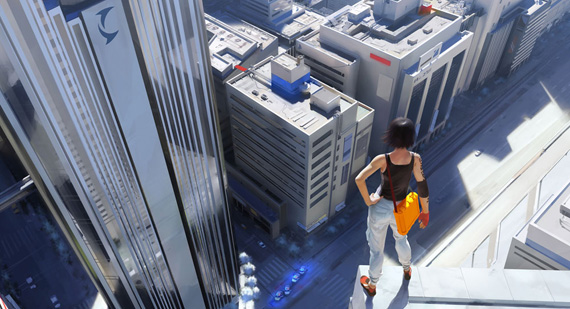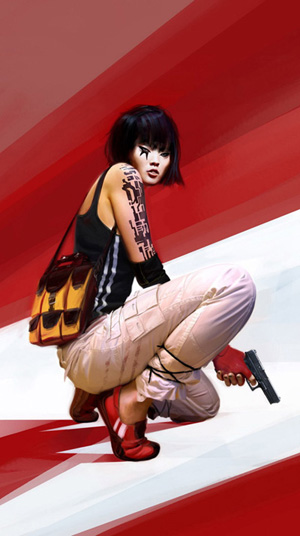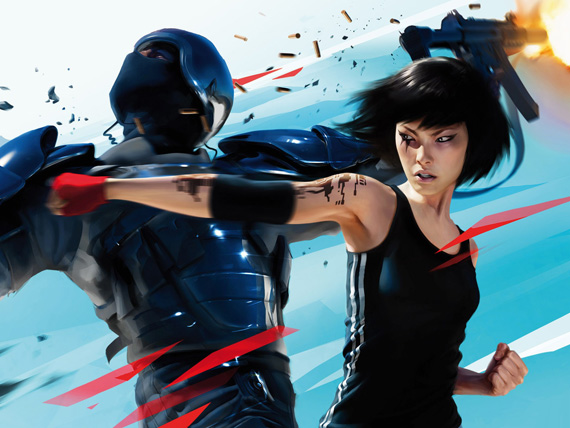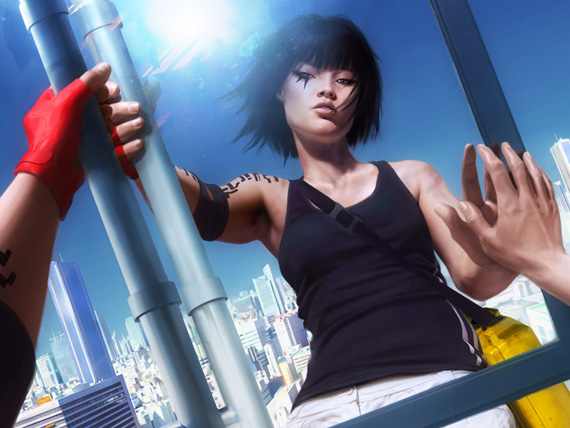
DICE’s long-anticipated release of Mirror’s Edge is the perfect example of a minefield for game journalists and reviewers. It’s a situation where there is no ideal position to take, where one is either criticized for praising a glorified technical demo or for criticizing innovation while consistently demanding it. In an industry that is plagued by repetition we should certainly be careful not to dismiss new ideas when they surface, but neither should we ignore the fact that the industry has evolved, and a game is not simply one element or mechanic, but the complete presentation that creates a world players find rewards from investing in.
Consequently Mirror’s Edge is certainly the most divisive title of the year, evoking extreme reactions, whether positive or negative upon playing. And it’s important to separate that statement from a simplistic argument between fans of Resistance and Gears of War. This is a situation where the developer has introduced innovation to an established genre, and thus the game faces both an audience seeking new experiences as well as those entrenched in a set style of game-play.

Wrestling with these notions, I found myself thinking back on last year, when there was a more universally excited response to Valve’s release of Portal. It was a game that also introduced innovation to the First Person Shooter genre, specifically changing the idea of how players could traverse game environments – a concept that proved instantly accessible to players and opened up wild possibilities for future applications. Yet it didn’t threaten the overall boundaries of the FPS standard. Despite changing the way in which a path could be taken, the act of moving through environments was still steeped in the mechanics of the FPS genre that Valve solidified with the Half-Life series. Though the player was given incredible new opportunities via the portal gun, experiencing the Aperture Science Labs felt like an extension of Gordon Freeman’s world. Mirror’s Edge instead seeks to completely change the way in which the player experiences the traversal of environments, and thus how they perceive the game world via the first person perspective. Where Portal was about changing the means by which one arrived, Mirror’s Edge is about the journey itself. The success of this experiment ultimately hinges on whether the player proves willing to invest in that experience.

It would belittle the game to refer to the experiment as poetry in motion. Even to refer to the poetry of motion summons titles like P.N.03, yet another experiment in how far an audience’s appreciation can stretch in finding pleasure from a title that focuses entirely on movement. But where P.N.03 sought to exemplify witnessing the art of movement, Mirror’s Edge strictly explores movement, period. It is, in the simplest terms, a game about motion. If we consider how Gran Turismo simulates vehicular motion – the act of driving, Mirror’s Edge applies that sensation to the extreme possibilities of personal movement through Parkour, often defined as the art of movement itself. The first person perspective seeks to make this a personal experience, immersing the player in its virtual world.
Mirror’s Edge can be considered a success as an experiment in simulating the sensation of movement to the player. Running over the city’s rooftops, building up speed while the wind picks up against Faith’s heavy breaths before leaping across the next building, or sliding beneath obstacles to maintain momentum – these sensations are the most unique experience to be offered to gamers in years.
The authenticity is enhanced by the most subtle additions such as Faith’s shadow appearing against walls as she approaches them, and her wavering as she catches her breath. When she jumps for higher ground her hands scramble to grab hold before pulling herself up. Oftentimes her hands fly out in front as she places them against a wall or steadies herself during a long jump. Just the dizzying effect I experienced from causing her to roll at the end of a far leap to absorb the shock was enough to draw me into the experience. Several chases throughout the game create situations in which my own heart rate matched Faith’s as I rushed to keep ahead of police bullets.
The game is simply at its best when the player is challenged to maintain Faith’s momentum.

Keeping Faith in constant motion is aided by an impressively simplistic control scheme, allowing players to pull off complex chains of movement with nothing more than a single tap of the button. When jumping, Faith will automatically grab hold and wait for another press before pulling herself up. Using the shoulder buttons only requires a single press at the approximate moment to cause her to jump, roll, or slide. Though combat situations are equally simplified, they can be mixed with the series of movements mentioned.
Direct combat is always an option, and enemies can be disarmed and have their weapons used against them to a degree. Weapons will only fire a few rounds before running out of ammunition. But the intentionally slimmed down gun play makes it far more satisfying to use Faith’s momentum against enemies. Striking from a wall run, or sliding toward an enemy and knocking him over the side of a building is often easier than trying to gun them down – and far slicker. During my play-through, there were only a few times I found it necessary to fire a weapon.
Though the game aims to avoid gun combat, players will find at least one situation where it is extremely aggravating not to. These situations break up the game’s running sequences, but offer so little in comparison that I often rushed through them eager to once again experience the core game-play. The one brief exception could be considered a boss encounter: a confrontation that had me quickly reacting to a main character’s attack and presented an interesting approach that could have been explored further. I don’t want to spoil the surprise for anyone who hasn’t played the game yet, but you’ll know it when you come to it.

The player’s ability to keep Faith in a constant state of movement ultimately leads to discussing the minimalist design of the city. It’s a fascist state, largely consisting of pristine skyscrapers with a few billboards and splashes of color. It’s an aesthetic that in one sense immediately causes the world to stand out, aptly suited to the serene soundtrack and more artistic aspects of savoring the vanilla sky. But this design is meant to aid the player, with the clean environment making it easier to foresee the path ahead, easier still when one chooses to allow hints to be delivered (certain objects are coloured red).
There are more puzzling moments, particularly in tighter areas where it may take longer to spy the proper route. Often I found that I had spent too much time looking for a more complex solution than the game had intended, almost refusing to accept that the answer could be so simple. In one instance I leaped off of one crane to land on a rooftop, and instantly seeing the ladder for a second crane made a dash to climb it and spy the next jump, when in fact I merely needed to run past it toward an awaiting door. But these instances were minor when considering just how often the game is able to make the path ahead of the player intuitive and obvious. Additionally, the ability to have Faith look in the right direction is far more subtle than positioning an arrow in the player’s field of vision, often proving more than enough to guide one to the goal.
The overall presentation is certainly not without merit, but the narrative development and plot is so minimal itself that it loses any chance of reaching the player in a meaningful way. A dry tale of police corruption, murder, and fascist rule can structure the game’s premise insofar as justifying Faith’s existence, but it never proves ambitious enough to earn the player’s attention. Furthermore, several cut-scenes are delivered via a series of low budget animations that seemingly illustrate last-minute attempts to tie the game together. Obviously DICE has focused primarily on the core game-play, and this is good. Mirror’s Edge attempts to be edgy and hip, and at all times that intention is painfully obvious and therein a failure. I don’t believe it’s out of the question for a design team to have outside sources craft a story around game-play mechanics. In fact, it will only become more essential as gamers come to expect a level of presentation that separates the “must play” and “must own” titles. In the absence of solid narrative and plot realization, there is little for Faith to do but run from point A to B, leaving players with far less game than was possible.

It’s a frustrating omission, considering the heights that attention could have given to the game. As only one possible alternative, consider how easily this style of game-play lends itself to the setting of information running, the type of futuristic cyber-punk world that William Gibson envisioned. Imagine the merger of that game-play with the cluttered world of Chiba City: environments where the player makes deeper connections with characters and places. A complete city would feed a richer story, where one eventually learns different paths and locations, using them in later situations with a more meaningful measure of choice. Mirror’s Edge presents only portions of the city, with no connection to previous levels, where additional paths toward your goal differ only slightly. The idea of multiple paths lends itself more to the online time trial mode, itself a feature that greatly extends the replay value, but demonstrates again why this is more a demonstration rather than a fully realized game.
I know I’ll continue struggling on where to position Mirror’s Edge for some time. It’s the type of game everyone needs to try, but more often than not will be set aside. Whether it remains an oddity or is developed through future titles has no bearing on the game today. But if we again return to Portal as an example, Valve didn’t simply introduce the portal gun to a standard FPS narrative. Obviously the story was designed around that innovation, but every element of that story was then crafted with as much attention as the portal gun itself. The presentation, plot, and characterization took the game from being a simple technical demonstration of a “new toy,” instead creating a game many considered the year’s best. Mirror’s Edge lacks that additional attention, content to deliver a lackluster story and slimmed-down environment, delivering incredibly visceral sensations but ultimately remaining a technical demonstration draped in poor window dressing.
As much as the player might feel the sensation of running through the environment, there is never any opportunity to become invested in the world of the game or its characters because there is no attempt made to draw the player in. For a game that makes every attempt to have players experience the world through Faith’s eyes, Mirror’s Edge makes no attempt to also put them in her shoes.